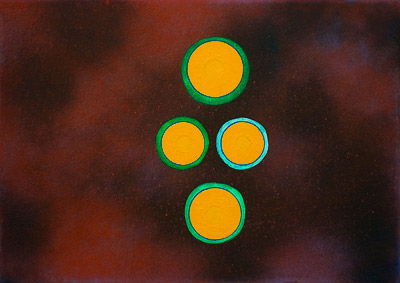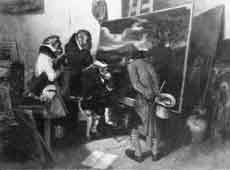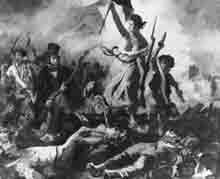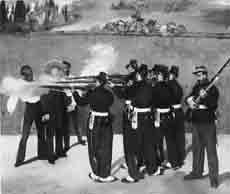Origins of Modernism
sitemap
drawings
paintings 1 2 2 3 4 5 a b c -
- A B . . . . . . . new
installations
projects
reviews
Adriano Frediani (1924-1983) |
Adriano Frediani (1924-1983) |
Origins of Modernism
The Political Origins of Modernism (Part 1)
Patricia Mainardi
The Political Origins of Modernism* (Part 2)
The government's presentation of such a varied bouquet of artists as Ingres, Delacroix, Decamps, and Vernet was intended-and understood-as an attempt to cover all bases, both aesthetic and political. Alexandre Decamps's precious little genre paintings (Fig. 5) were known to be the favorites of the bourgeoisie and were widely criticized as reflecting the attributes of that class; namely, a rich and pleasant veneer concealing an essential lack of education and an absence of elevated principles.[29] Horace Vernet glorified French military victories and was acknowledged to be the most popular artist in France, the only one known to the common people. For conservatives he was a symbol of patriotism, for progressives of chauvinism.[30] In truth, one could find exceptions to these interpretations-aristocrats who favored Decamps, political radicals who detested Delacroix-but that is not the point.[31] The main issue is that these stereotypes had enough reality to be invoked repeatedly by both critics and government officials in defining the 1855 Exposition.
This strategy can be seen as an extension of Second Empire politics, for, as Theodore Zeldin has pointed out, government policy was to encourage prominent representatives of various political persuasions to rally to its support.[32] It is my theory that the same policy was pursued in art, and here I differ with Albert Boime's theory that the government attempted to make Realism the official style.[33] On the contrary, the regime was content merely to ratify all existing trends, provided that their principal proponents rallied to the Empire. In fact, there was no one in the Second Empire art administration who was capable of creating or carrying out a coherent policy.
The government's eclecticism in honoring a multitude of styles was reinforced by the jury, which, under the presidency of Morny, Napoleon Ill's half-brother (and the chief architect of his coup d'état), awarded Medals of Honor to nine different artists.[34] It was again the conservatives who understood the ramifications of this gesture, protesting that all styles were thus considered implicitly neutral and interchangeable, their differences reduced to mere questions of taste and popularity.[35] Conservatives understood quite well that the government had dealt a fatal blow to the classical hierarchy of categories, for it had established the principle that one could become as great an artist by painting monkeys as by painting gods and heroes.
Fig. 5. Alexandre Decamps, The Experts, 1837.
But in order for gods and monkeys, to say nothing of apples and farmyards, to be accorded the same potential for greatness, subject and style had first to be disencumbered of their heavy political baggage. It was necessary to create a politically neutral methodology for evaluating art. This was done by Théophile Gautier and Prince Napoleon. Gautier, the only major art critic who had rallied to the Empire, was in consequence appointed official government critic for the Exposition.[36] His natural propensity to say something nice about everyone would, in this context, be politically valuable. Prince Napoleon, President of the Exposition, turned art critic for the occasion and established the official line on each artist. Of Delacroix, whose Liberty Leading the People (Fig. 6) was removed from storage for the event, he wrote:
There are no longer any violent discussions, inflammatory opinions about art, and in Delacroix the colorist one no longer recognizes the flaming revolutionary whom an immature School set in opposition to Ingres. Each artist today occupies his legitimate place. The 1855 Exposition has done well to elevate Delacroix; his works, judged in so many different ways, have now been reviewed, studied, admired, like all works marked by genius.[37]
Delacroix the Revolutionary has been transformed into Delacroix the Colorist, and the quality of genius has been pressed into service to neutralize and depoliticize his art. Gautier praised this laundered version of Delacroix to such an extent that the artist informed him that a friend "assured me, after having heard your article read, that she thought I had died, thinking that one only so praised those dead and buried."[38] The reference to death was apt: a number of critics referred to 1855 as a cemetery.[39] What was dead and buried was the contemporary political vitality of art; art would henceforth be confined to museums. After 1855, Delacroix was elected to the Academy despite six previous failures, and even Courbet was affected by the new ambiance and became somewhat acceptable.[40] One may note that Marxist historians often cite 1855 as the end of Courbet's great political period.[41] Delacroix's friend Perignon, looking back to the Universal Exposition, wrote, "Today everything is forgotten, everything is smoothed over, there are no longer either halos or scars; the works appear isolated, deprived of the interest they had borrowed from circumstances, from judgments, from passing events. Above all, they've lost the train of violent passions that gave them their magic life."[42]
Fig. 6. Eugène Delacroix, Liberty Leading the People, 28 July 1830, 1830.
The magic life that disappeared with 1855 was the ability of art to carry many significances in popular understanding, to serve as vehicle for a variety of discourse. Violent passions did not, of course, disappear, but in a sense 1855 is the cemetery that marks the end of the political art wars of the first half-century. The canonization of all opposing styles after decades of vituperation had a traumatic effect on contemporaries; an article in one of the art periodicals lamented-and this is the modernist lament: "Alas, in art as in politics, isn't the error of today almost always the truth of tomorrow."[43] The security offered by tradition was giving way to the anxiety of the present, for in all facets of life France at mid century was moving into uncharted waters.
Aesthetic evaluations later in the century tended to replace political judgments with moral ones and moral judgments with formal ones. The schism of the earlier period, Academic or anti-Academic, encompassing at the same time both aesthetic and political issues, was replaced by the merely formal judgment, stated by Mallarmé in 1874 as "The jury has only to say: this is a painting or that is not a painting.”[44] The eclecticism of the earlier period, so valuable in breaking the hegemony of history painting, proved to be but an interim stance, soon to be replaced by the hegemony of modernism.
The modernist view of art as content-less and politically neutral, which we take as the grounding of all that makes Manet at once so enigmatic and provocative, thus had its seeds in the deliberate manipulation of power, in Napoleon Ill's successful attempt to deprive art of its traditional role as partisan tool in order to co-opt it as window dressing for his regime. We may cite Mallarmé, Roger Fry, and Clement Greenberg as brilliant theoreticians of modernism, but at the same time we must acknowledge the role of Napoleon III, Prince Napoleon, and the Due de Morny, for it was they who, even earlier, saw the political advantage that might be derived from neutralizing art.
And so, if Delacroix's Liberty seems more straightforward in its sympathies than does Manet's Execution of Maximilian (Fig. 7), if Delacroix was a symbol of revolution and Manet of modernism, if, in fact, neither artist was politically radical and both paintings, as recent scholarship has emphasized, share an enigmatic quality, one may account for these differences by the "magic life" that Liberty enjoyed, but that no longer existed in 1867.
Fig. 7. Manet, The Execution of the Emperor Maximilian, 1868.
I propose that we not leave modernism to be defined by modernists, who would state that the issues raised here are peripheral or irrelevant. Instead I suggest that whenever there is an attempt to separate art from its social and political milieu by redefining it exclusively in formalist terms, we look for two interrelated phenomena. One is the attempt on an institutional level to co-opt it for political advantage. The other is the parallel attempt on the aesthetic level, by artists and their friends, to protect art from partisan attacks by stressing its political insignificance. In any case, modernism has existed from the very beginning, Janus-faced, in this contradiction: one face gazes resolutely at the work of art, the other attentively regards current events.
* Patricia Mainardi; The Political Origins of Modernism, Art Journal, Vol. 45, No.1, Manet, Spring, 1985, pp. 14-17.
Notes:
[29] See: Gustave Planche, "L'Exposition des Beaux-Arts à l'Exposition Universelle de 1855," Revue des Deux-Mondes. September 15, 1855, p. 1150; Antoine Etex, Essai d'une revue synthétique sur l'Exposition Universelle de 1855. Paris, 1856, pp. 37-39.
[30] For the identification with patriotism, see: Claude Vignon [Noémi Cadiot], Exposition Universelle de 1855. Beaux-Arts. Paris, 1855, p. 220; for the charge of chauvinism, see: Maxime DuCamp, Les Beaux-Arts à l'Exposition Universelle de 1855. Paris, 1855, p. 205.
[31] In a recent article, Francis Haskell has attempted to use the exceptions to disprove the rule by citing critics whose politics and aesthetic positions were incongruent as well as collectors whose taste differed from the expected norm. This only demonstrates that history is a social science; regardless of individual variants, the generalization stands. See: Francis Haskell, "Enemies of Modern Art," New York Review of Books, June 30, 1983, pp. 19-25.
[32] See: Theodore Zeldin, The Political System of Napoleon III, London, 1958.
[33] See: Boime 1982.
[34] Besides Ingres, Delacroix, Decamps, and Vernet, the medallists included Cornelius, Landseer, Leys, Heim, and Meissonier. The lists are included in the 1857 Salon catalogue.
[35] See: Charles Blanc, "Au Secrétaire de la Rédaction," La Presse. October 30, 1855. Delacroix noted in his Journal. October 15, 1855, that the Academicians were outraged over the plurality of medals.
[36] On Gautier, see: Taxile Delord, Histoire du second Empire. 1848-1869. 6 vols., Paris, 1869-75, II, p. 272. His articles were published in the official Government newspaper, Le Moniteur Universel.
[37] Prince Napoleon (cited n. 23), pp. 118-19; 1855 is mistakenly written as 1851 in the text.
[38] Delacroix to Théophile Gautier, July 22, 1855, in Eugène Delacroix, Correspondance générale. André Joubin, ed., 5 vols., Paris, 1926-38, III, pp. 279-80.
[39] See, for example: Paul Mantz, "Salon de 1857," La Revue Française IX (1857), p. 422.
[40] See: Louis Hautecoeur, "Delacroix et l'Académie des Beaux-Arts," Gazette des Beaux-Arts 62 (December 1963), pp. 349-64.
[41] See, for example: Clark, (cited n. 19), pp. 155-56.
[42] Alexis-Joseph Pérignon, A Propos de l'Exposition de peinture. Paris, 1856, pp. 3-4.
[43] "Chronique," La Revue Universelle des Arts. 1855, I, p. 240.
[44] Stéphane Mallarmé, "Le Jury de Peinture pour 1874 et M. Manet," in Oeuvres complètes de Stéphane Mallarmé. Henri Mondor and G. Jean-Aubry, eds., Paris, 1945, p. 699.




